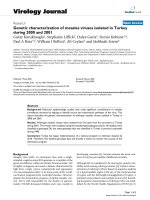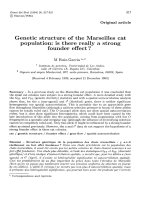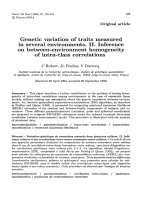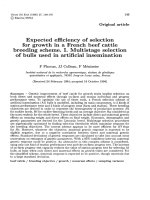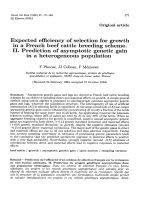Báo cáo sinh học: " Genetic diversity of a large set of horse breeds raised in France assessed by microsatellite polymorphism" pot
Bạn đang xem bản rút gọn của tài liệu. Xem và tải ngay bản đầy đủ của tài liệu tại đây (150.59 KB, 3 trang )
BioMed Central
Page 1 of 3
(page number not for citation purposes)
Genetics Selection Evolution
Open Access
Correction
Genetic diversity of a large set of horse breeds raised in France
assessed by microsatellite polymorphism
Grégoire Leroy*
1,2
, Lucille Callède
1,2
, Etienne Verrier
1,2
, Jean-
Claude Mériaux
3
, Anne Ricard
4
, Coralie Danchin-Burge
1,2
and
Xavier Rognon
1,2
Address:
1
AgroParisTech, UMR1236 Génétique et Diversité Animales, 16 rue Claude Bernard, F-75321 Paris, France,
2
INRA, UMR1236 Génétique
et Diversité Animales, 78352 Jouy-en-Josas, France,
3
LABOGENA, F-78352 Jouy-en-Josas, France and
4
INRA, UR631 Station d'amélioration
génétique des animaux, BP 52627, 31326 Castanet-Tolosan, France
Email: Grégoire Leroy* - ; Lucille Callède - ;
Etienne Verrier - ; Jean-Claude Mériaux - ;
Anne Ricard - ; Coralie Danchin-Burge - ;
Xavier Rognon -
* Corresponding author
Abstract
After the recent publication of our article (Leroy, Genetics Selection Evolution 2009 41:5), we found
several errors in the published Table Three, concerning the computation of contribution to within-
breed diversity (CW). We apologize to the readers for these errors, which are corrected in the
present erratum.
Correction
Table Three (see Table 1 of this erratum) of our recently
published paper [1] contains several errors. Here we
present the corrected version of Table Three (see Table 2
of this erratum) and explain the new data. The authors
regret the errors.
Results
Partition of diversity
Errors concern the computation of the CW component
developed by Ollivier and Foulley [2]. In the new version,
CW ranged from -1 to 0.78. As aggregate diversity D is
defined as a linear combination of CW and contribution
to between-breed diversity, column D had also to be cor-
rected, and ranged from -0.30 to 1.18. Consequently, the
Pearson correlation between CW and ΔGD
WS
was found
to be -1 (instead of -0.72 in the previous version), and the
Pearson correlation between D and ΔGD
T
was found to be
-0.59 (P = 0.008).
Discussion
Conservation priorities
In spite of the above modifications, the populations that
contributed most to the total diversity, according to the
approaches of Ollivier and Foulley [2] and Caballero and
Toro [3], still remain mostly the non-endangered breeds
(AR, PFS, TF) [instead of AR, PS, SF, TF in the previous ver-
sion].
On the contrary, when considering the eight breeds classi-
fied as endangered or endangered/maintained by the FAO
(ARD, AUX, BOUL, LAND, MER, POIT, POT, TDN) and
the approach of Ollivier and Foulley [2], a change is noted
for the breeds exhibiting the highest contributions to
Published: 19 March 2009
Genetics Selection Evolution 2009, 41:31 doi:10.1186/1297-9686-41-31
Received: 12 March 2009
Accepted: 19 March 2009
This article is available from: />© 2009 Leroy et al; licensee BioMed Central Ltd.
This is an Open Access article distributed under the terms of the Creative Commons Attribution License ( />),
which permits unrestricted use, distribution, and reproduction in any medium, provided the original work is properly cited.
Genetics Selection Evolution 2009, 41:31 />Page 2 of 3
(page number not for citation purposes)
Table 1: Original and incorrect Table Three presented in Leroy et al. (2009)
Breed
code
Nb of breeding animals
in 2005
Pr.
extinction
Agregate diversity and cryopreservation
potential
(Ollivier and Foulley, 2005)
Loss or gain of diversity when a breed is
removed and contributions to optimal diversity
(Caballero and Toro, 2002)
Males Females CW CB D CP ΔGD
WS
ΔGD
BS
ΔGD
T
C
i
AA 0.11 0.35 0.85 0.39 0.10 -0.0013 -0.0018 -0.0031 0%
AR 480 2 130 0.03 0.29 10.90 1.25 0.35 -0.0015 -0.0010 -0.0026 0%
ARD 187 1 417 0.08 -0.48 1.33 -0.32 0.10 0.0031 0.0001 0.0032 0%
AUX 24 248 0.57 -0.19 3.14 0.11 1.79 0.0023 -0.0005 0.0018 0%
BOUL 58 540 0.24 -0.27 12.35 0.87 2.95 0.0040 -0.0023 0.0018 6%
BR 621 6 380 0.02 -0.38 5.57 0.16 0.12 0.0016 0.0009 0.0024 0%
CAM 118 837 0.12 0.00 7.99 0.73 0.97 -0.0018 0.0013 -0.0006 0%
COBND 63 760 0.21 -0.06 2.42 0.16 0.52 -0.0017 0.0019 0.0002 2%
COMT 856 7 073 0.02 -0.25 3.63 0.11 0.06 0.0000 0.0015 0.0015 0%
LAND 22 73 0.74 0.06 3.99 0.41 2.95 -0.0029 0.0016 -0.0014 2%
MER 93 1 012 0.15 -0.04 10.41 0.91 1.53 0.0000 0.0001 0.0001 0%
PER 183 2 461 0.07 -0.32 4.60 0.12 0.34 0.0006 0.0014 0.0020 0%
PFS 100 949 0.14 0.39 1.93 0.53 0.27 -0.0055 0.0024 -0.0031 70%
POIT 39 199 0.38 -0.43 12.60 0.75 4.83 0.0069 -0.0030 0.0039 0%
POT 94 910 0.15 0.19 1.33 0.29 0.20 -0.0040 0.0024 -0.0016 5%
PS 369 8 049 0.04 0.50 6.17 1.02 0.22 -0.0001 -0.0041 -0.0042 1%
SF 474 11 700 0.03 0.45 1.33 0.53 0.04 -0.0024 -0.0013 -0.0037 15%
TDN 16 183 0.85 -0.17 1.93 0.02 1.64 0.0032 -0.0009 0.0022 0%
TF 527 15 950 0.02 0.36 7.51 1.01 0.18 -0.0002 -0.0029 -0.0032 0%
Sum 0 100 9.054 0 -0.043 0.043 100%
CW = contribution to within-breed diversity; CB = contribution to between-breed diversity; D = aggregate diversity;CP = cryopreservation potential;
ΔGD
WS
= loss or gain of gene diversity within populations when breed is removed; ΔGD
BS
= loss or gain of gene diversity between populations when
breed is removed; ΔGD
T
= loss or gain of total diversity when the breed is removed; C
i
= contribution of the breed to optimise GD
T
Table 2: Corrected Table Three
Breed
code
Nb of breeding animals
in 2005
Pr.
Extinction
Agregate diversity and cryopreservation
potential
(Ollivier and Foulley, 2005)
Loss or gain of diversity when a breed is
removed and contributions to optimal diversity
(Caballero and Toro, 2002)
Males Females CW CB D CP ΔGD
WS
ΔGD
BS
ΔGD
T
C
i
AA 119 1 443 0.11 0.18 0.85 0.24 0.10 -0.0013 -0.0018 -0.0031 0%
AR 480 2 130 0.03 0.21 10.90 1.18 0.35 -0.0015 -0.0010 -0.0026 0%
ARD 187 1 417 0.08 -0.46 1.33 -0.30 0.10 0.0031 0.0001 0.0032 0%
AUX 24 248 0.57 -0.32 3.14 -0.01 1.79 0.0023 -0.0005 0.0018 0%
BOUL 58 540 0.24 -0.60 12.35 0.57 2.95 0.0040 -0.0023 0.0018 6%
BR 621 6 380 0.02 -0.24 5.57 0.29 0.12 0.0016 0.0009 0.0024 0%
CAM 118 837 0.12 0.27 7.99 0.97 0.97 -0.0018 0.0013 -0.0006 0%
COBND 63 760 0.21 0.24 2.42 0.44 0.52 -0.0017 0.0019 0.0002 2%
COMT 856 7 073 0.02 -0.01 3.63 0.32 0.06 0.0000 0.0015 0.0015 0%
LAND 22 73 0.74 0.48 3.99 0.79 2.95 -0.0029 0.0016 -0.0014 2%
MER 93 1 012 0.15 0.02 10.41 0.96 1.53 0.0000 0.0001 0.0001 0%
PER 183 2 461 0.07 -0.10 4.60 0.33 0.34 0.0006 0.0014 0.0020 0%
PFS 100 949 0.14 0.78 1.93 0.89 0.27 -0.0055 0.0024 -0.0031 70%
POIT 39 199 0.38 -1.00 12.60 0.23 4.83 0.0069 -0.0030 0.0039 0%
POT 94 910 0.15 0.58 1.33 0.64 0.20 -0.0040 0.0024 -0.0016 5%
PS 369 8 049 0.04 0.01 6.17 0.57 0.22 -0.0001 -0.0041 -0.0042 1%
SF 474 11 700 0.03 0.34 1.33 0.43 0.04 -0.0024 -0.0013 -0.0037 15%
TDN 16 183 0.85 -0.41 1.93 -0.20 1.64 0.0032 -0.0009 0.0022 0%
TF 527 15 950 0.02 0.02 7.51 0.70 0.18 -0.0002 -0.0029 -0.0032 0%
Sum 0 100 9.054 0 -0.043 0.043 100%
CW = contribution to within-breed diversity; CB = contribution to between-breed diversity; D = aggregate diversity;CP = cryopreservation potential;
ΔGD
WS
= loss or gain of gene diversity within populations when breed is removed; ΔGD
BS
= loss or gain of gene diversity between populations when
breed is removed; ΔGD
T
= loss or gain of total diversity when the breed is removed; C
i
= contribution of the breed to optimise GD
T
Publish with Bio Med Central and every
scientist can read your work free of charge
"BioMed Central will be the most significant development for
disseminating the results of biomedical research in our lifetime."
Sir Paul Nurse, Cancer Research UK
Your research papers will be:
available free of charge to the entire biomedical community
peer reviewed and published immediately upon acceptance
cited in PubMed and archived on PubMed Central
yours — you keep the copyright
Submit your manuscript here:
/>BioMedcentral
Genetics Selection Evolution 2009, 41:31 />Page 3 of 3
(page number not for citation purposes)
aggregate diversity D, which are now MER, LAND and
POT, instead of BOUL, MER and POIT.
Finally, since the discussion on breed conservation is
based on the use of several other methods and parame-
ters, the above new results do not change our recommen-
dations on which breeds specifically need support.
References
1. Leroy G, Callede L, Verrier E, Mériaux JC, Ricard A, Danchin-Burge
C, Rognon X: Genetic diversity of a large set of horse breeds
raised in France assessed by microsatellite polymorphism.
Genet Sel Evol 2009, 41:5.
2. Ollivier L, Foulley JL: Aggregate diversity: New approach com-
bining within- and between-breed genetic diversity. Livest Prod
Sci 2005, 95:247-254.
3. Caballero A, Toro MA: Analysis of genetic diversity for the
management of conserved subdivided populations. Conserv
Genet 2002, 3:289-299.

